The brown pattern ceramics of Ly-Tran dynasties were made carefully with thick bone and brown glazed patterns against ivory glazed ground or with brown glaze only. This included types of domestic wares and ceremonial purposes, such as: ewer, tureen, jar, bowl, vase, lamp-stand, basin, cup, plate, box, stupa, urn, stem-cup, statue…
They also include some kinds of large jars. Their typical style was brown inlaid patterns in reserve against an ivory glazed ground. Besides, some had under-glazed brown patterns and ivory glaze which resembling the cobalt blue pattern ceramics. On the other hand, the embossment decoration was also applied.
Their decorative patterns reflect Buddhism and Taoism influence and otherwise human and nature. It also related to the pattern designs of other contemporary ceramics, such as white glazed ceramics, celadon glazed ceramic as well as other materials including stone, terra-cotta, wood, bronze, gold…
Decorative motif:
– Buddhism such as Buddha figure sitting on the lotus petal pedestal, Kinnara and Kinnari, the male and female half-bird and half-human singers for Indra, the Indian Rain God…
– Dragon was not popular but already on the lid of the box or stupa and this is an important mark for defining the date of the object.
– Motif of human activities was exploited and this is one of the most attractive subjects for the antiquity collectors. The spearmen figure exercising of fighting or hunting with sword and shield on their hand reflected the atmosphere of the country in the resistance against Mongol Empire.
– Animal motif as elephant, tiger, horse, deer and birds as cock, peacock, parrot… or aquatic creatures as fish or prawn.
– Vegetation motif as lotus flower, lotus petal band that were carved on the shoulder of the ewer, situla, tureen, plate, vase base, box … In particular, the lotus petal band that was made in different styles was a feature for determining the date of the object. For example, if the lotus petal band is embossed, and the lotus petal is big or small size, long or fat, equal and elaborate, the object can be dated to Ly dynasty. Otherwise, if the lotus petal is flat, and the petal’s top-end is round, the object can be Tran style. The lotus flower patterns could be inlaid or brown glazed were very common on products such as ewer, jar, lamp-stand, urn, tureen… The lotus flower was normally described in various forms: tiered lotus petal pedestal, carved or molded lotus petal collar on the shoulder of jars, inlaid lotus scrolls, inlaid lotus flower and leaves repeated in panels, potted spray and stylized lotus.
The brown ceramics were crafted in the following ways:
– Ivory inlaid patterns in reserve against a brown glazed ground
– Brown inlaid patterns in reserve against an ivory glazed ground
– Unglazed patterns carved through brown glaze
– Under-glaze brown patterns and ivory glaze
Regarding the date of the ceramic:
Based on the data of the inscription, motif of the objects that found through excavations or accidentally, the date of the ceramics could be determined to date: Ly dynasty (11th -13th century), Tran dynasty (13th – 14th century) and Tran-Early Le (14th – 15th century).
Here are some examples of the ceramic:
– Ewer of the Ly dynasty can be in shape of a peach, decorated with Kinnari with two hands holding the ewer’s spout, brown glazed on its head, wing, leg and tail, ivory glazed ground. One ewer has a body lobed into lotus petals covered with brown glaze, lotus petal collar on shoulder, bands of brown glaze on neck and shoulder. All decorated being glazed brown under an ivory glaze ground. (see picture)

Ewer in Tran dynasty includes a piece of ewer in elephant shape with driver, ivory glaze ground with brown glazed decorative detail. Or ewer in bulbous body, bending spout, spiral handle, chicken-foot decoration.
In 14th-15th century, brown ewer has a melon shape, dragon-head spout, body carving a round band of flower scroll and elipses between 2 brown paralel lines.
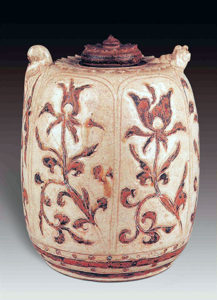
– Vase in Ly dynasty has flaring mouth, short neck, globular body, band of tiny circle in brown glazed on the neck and foot. Or in yuhuchun shape, body molded into petal-slices incised with foliage.
Vase at the end of Tran and early Le dynasty has cylindrical shape, heavy rim, flat base, embossed dragon- shape shoulder and two horizontal ears, decorated with three bands of flower and wave in brown glazed on ivory glaze ground.
– Basin remnants were found in Thang Long citadel relic. A broken sample of the basin has a thick rim, carving lotus petals, brown and ivory white glaze. Another sample was decorated with lemon flower, cloud pattern and flower scroll.
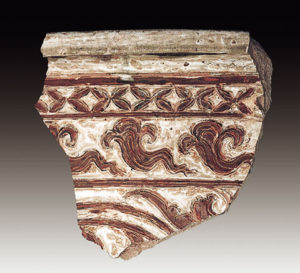
In the Tran dynasty ceramic site in Da Ton commune (Gia Lam, Hanoi), basins of brown ceramic have been found. They are basins with rim, curved edge, large base, with inlaid brown lotus flower pattern decoration repeated in four panels on exterior, similar to those found in Tam Duong site, Thai Binh province.
Also in Da Ton site, in 1978, an accidental excavation had found two brown basins together with 3 cobalt blue pattern plates. Those two basins have been preserved in Ha Noi Museum. One is decorated with apricot flower band and inlaid brown classic scrolling on ivory white ground. The other was brown glazed on whole exterior, apricot band carving, and inlaid unglazed flower in the lower part. Those artifacts resembled to brown ceramic products in Bat Trang village which located next by Da Ton village, and dated back to 14th-15th century (end of Tran, early Le).
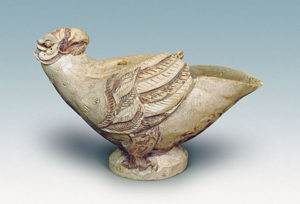
– Plates in shape of lotus petals were found in Thang Long sites. They are ones with flat and unglazed bottom and inlaid lotus flower patterns, exterior decorated with 2 or 3 layers of lotus petals, dancing lady decoration on the base. On the rim or around the base can decorate brown glazed tiny rings band.
– Statues: Ly dynasty’s statues found in Thang Long site, there was a ewer in parrot shape, standing on flattened round unglazed base, head, wings and legs in brown glazed, ivory glazed ground. A statue of cat in 7,5cm height, in a shape of a cat sitting, brown and ivory glazed.
Tran dynasty’s statues include a ewer in elephant shape with driver, ivory glazed ground with brown glazed decorative detail. Or human heads with hair bound in a turban, 4-5cm height, brown glazed. Or statue of an elephant driver, brown glaze, 10cm height with trunk bent up to the forehead.
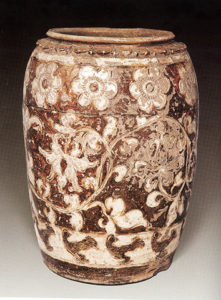
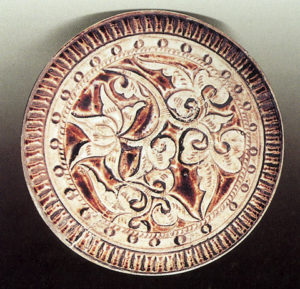
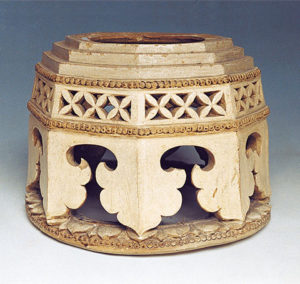
* The brown glazed ceramics in Ly and Tran dynasty represent a fascinating development in the history of Vietnamese ceramics. The ceramics of this period had reached to a top level in the style design and decoration. The designs were so sophisticated to turn the objects to be real artworks. The bone were high quality resulted from good filtering and firing. The glaze was shiny and deep making the products beautifully. The motifs exploited were so various, from fauna and floral subjects to Buddhism symbols, especially the lotus.
Brown pattern and brown ceramics of Ly and Tran dynasty are not only high quality but also represent for a spirit of reviving Vietnamese traditional cultural values. For example, the common motif of Dong Son culture as “S” character, dotted line, ladder motif and anticlockwise flying birds…
Dr. Nguyen Dinh Chien (Former Deputy Director of VNMH)
EN: Tran Trang
Source: baotanglichsu.vn